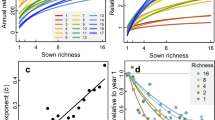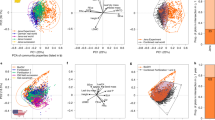Abstract
The world is witnessing a decline in biodiversity which may be greater in magnitude than even previous mass-extinction events1,2,3. This has rekindled interest in the relationships between biodiversity and the stability of community and ecosystem processes4 that have been reported in some empirical studies5,6,7. Diversity has been linked with community and ecosystem processes8,9,10,11,12,13,14, but disputes remain over whether it is diversity, environmental factors or the variety of functional groups in a community that drive these patterns15,16,17,18,19,20,21. Furthermore, it remains unclear whether variation in diversity resulting from species loss within communities has similar effects on stability as natural variation in diversity associated with gradients in factors that regulate diversity. We believe that, across larger ecological scales, extrinsic determinants of biodiversity such as disturbance regimes and site history may be the primary determinants of certain measures of community stability. Here we use controlled field experiments in savanna grasslands in southern India to demonstrate and explain how low-diversity plant communities can show greater compositional stability when subject to experimental perturbations characteristic of their native environments. These results are best explained by the ecological history and species characteristics of communities rather than by species diversity in itself.
This is a preview of subscription content, access via your institution
Access options
Subscribe to this journal
Receive 51 print issues and online access
$199.00 per year
only $3.90 per issue
Buy this article
- Purchase on Springer Link
- Instant access to full article PDF
Prices may be subject to local taxes which are calculated during checkout


Similar content being viewed by others
References
Wilson,E. O. The Diversity of Life (Norton, New York, 1992).
Steadman,D. W. in Biodiversity II (eds Reaka-Kudla, M. L., Wilson, D. E. & Wilson, E. O.) 139–162 (Joseph Henry, Washington DC, 1997).
Russell,G. J., Brooks,T. M., McKinney,M. M. & Anderson,C. G. Present and future taxonomic selectivity in bird and mammal extinctions. Conservation Biol. 12, 1365–1376 (1998).
Schulze,E. D. & Mooney,H. A. (eds) Biodiversity and Ecosystem Function (Springer, Berlin, 1993).
Hurd,L. E., Mellinger,M. V., Wolf,L. L. & McNaughton,S. J. Stability and diversity at three trophic levels in terrestrial ecosystems. Science 173, 1134–1136 (1971).
McNaughton,S. J. Diversity and stability of ecological communities: a comment on the role of empiricism in ecology. Am. Nat. 111, 515–525 (1977).
McNaughton,S. J. in Biodiversity and Ecosystem Function (eds Schulze, E. D. & Mooney, H. A.) 361–383 (Springer, Berlin, 1993).
Tilman,D. & Downing,J. A. Biodiversity and stability in grasslands. Nature 367, 363–365 (1994).
Naeem,S., Thompson,L. J., Lawler,S. P., Lawton,J. H. & Woodfin,R. M. Declining diversity can alter the performance of ecosystems. Nature 368, 734–737 (1994).
Naeem,S., Thompson,L. J., Lawler,S. P., Lawton,J. H. & Woodfin,R. M. Empirical evidence that declining diversity can alter the performance of ecosystems. Phil. Trans. R. Soc. Lond. B. 347, 249–262 (1995).
Tilman,D., Wedin,D. & Knops,J. Productivity and sustainability influenced by biodiversity in grassland ecosystems. Nature 379, 718–720 (1996).
Naeem,S., Hakansson,K., Lawton,J. H., Crawley,M. J. & Thompson,L. J. Biodiversity and productivity in a model assemblage of plant species. Oikos 76, 259–264 (1996).
Grady-Steed,J., Harris,P. M. & Morin,P. J. Biodiversity regulates ecosystem predictability. Nature 390, 162–165 (1997).
Naeem,S. & Li,S. Biodiversity enhances ecosystem reliability. Nature 390, 507–509 (1997).
Tilman,D. et al. The influence of functional diversity on ecosystem processes. Science 277, 1300–1302 (1997).
Hooper,D. U. & Vitousek,P. M. The effect of plant composition and diversity on ecosystem processes. Science 277, 1302–1305 (1997).
Hooper,D. U. & Vitousek,P. M. Effects of plant composition and diversity on nutrient cycling. Ecol. Monogr. 68, 121–149 (1998).
MacGillivray,C. W. et al. Testing predictions of the resistance and resilience of vegetation subjected to extreme events. Functional Ecol. 9, 640–649 (1995).
Huston,M. A. Hidden treatments in ecological experiments: re-evaluating the ecosystem function of biodiversity. Oceologia 110, 449–460 (1997).
Grime,J. P. Biodiversity and ecosystem function: the debate deepens. Science 277, 1260–1261 (1997).
Wardle,D. A. A more reliable design for biodiversity study? Nature 394, 30 (1998).
Frank,D. A. & McNaughton,S. J. Stability increases with diversity in plant communities: empirical evidence from the 1988 Yellowstone drought. Oikos 62, 360–362 (1991).
Doak,D. F. et al. The statistical inevitability of stability-diversity relations in community ecology. Am. Nat. 151, 264–276 (1998).
Tilman,D., Lehman,C. L. & Bristow,C. E. Diversity-stability relationships: statistical inevitability or ecological consequence. Am. Nat. 151, 277–282 (1998).
Ricklefs,R. E. Community diversity: relative roles of local and regional processes. Science 235, 167–171 (1987).
Barbault,R. & Sastrapradja,S. in Global Biodiversity Assessment (ed. Heywood, V. H.) 193–274 (Cambridge Univ. Press, 1995).
Tilman,D. Biodiversity: population versus ecosystem stability. Ecology 77, 350–363 (1996).
Pimm,S. L. The Balance of Nature? (Univ. Chicago Press, 1991).
MacArthur,R. H. Fluctuations of animal populations and a measure of community stability. Ecology 36, 533–536 (1955).
Acknowledgements
We thank the Tamil Nadu Forest Department for granting permission to work at KMTR, and J. Ratnam for support and comments. We also thank L. L. Wolf, D. Frank, T. R. Shankar Raman and D. Barua for comments; R. Ali, V. Vinatha, K. Kar Gupta, M. Katti, D. Mudappa, N. M. Ishwar, K. Vasudevan and K. S. Gopi for their help; and C. Sankaran, P. Kumar and C. Jayseelan for field assistance. This work was supported by the Wildlife Conservation Society (India), NSF and the Sophie Danforth Conservation Biology Fund.
Author information
Authors and Affiliations
Corresponding author
Rights and permissions
About this article
Cite this article
Sankaran, M., McNaughton, S. Determinants of biodiversity regulate compositional stability of communities. Nature 401, 691–693 (1999). https://doi.org/10.1038/44368
Received:
Accepted:
Issue Date:
DOI: https://doi.org/10.1038/44368
This article is cited by
-
Relationships of community diversity with distributions of rare species, non-native plants, and compositional stability in a temperate forest–open habitat landscape
Community Ecology (2023)
-
Eutrophication weakens stabilizing effects of diversity in natural grasslands
Nature (2014)
-
Exotic shrub invasion in a montane grassland: the role of fire as a potential restoration tool
Biological Invasions (2012)
-
Communities of different plant diversity respond similarly to drought stress: experimental evidence from field non-weeded and greenhouse conditions
Naturwissenschaften (2012)
-
Seasonal variability of bacteria in fine and coarse urban air particulate matter
Applied Microbiology and Biotechnology (2011)
Comments
By submitting a comment you agree to abide by our Terms and Community Guidelines. If you find something abusive or that does not comply with our terms or guidelines please flag it as inappropriate.



